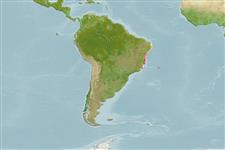Classification / Names
ชื่อสามัญ | ชื่อพ้อง | Catalog of Fishes(สกุล, ชนิด) | ITIS | CoL | WoRMS | Cloffa
>
Blenniiformes (Blennies) >
Blenniidae (Combtooth blennies) > Salariinae
Etymology: poiti: Named after the Oceanographic Post of Trindade Island of the Brazilian Navy..
Environment: milieu / climate zone / depth range / distribution range
นิเวศวิทยา
เกี่ยวกับทะเล,น้ำเค็ม เกี่ยวกับหินโสโครก; ระดับความลึก 0 - 1 m (Ref. 49353). Tropical
Southwest Atlantic: Trindade Island, Brazil.
ขนาด / น้ำหนัก / Age
Maturity: Lm ? range ? - ? cm
Max length : 8.5 cm SL เพศผู้/กระเทย; (Ref. 49353); 8.0 cm SL (female)
Short description
เครื่องมือที่ใช้ในการแยกชนิดสัตว์,สิ่งมีชีวิตออกจากกัน | สัณฐานวิทยา | ความยาวต่างๆ
เงี่ยงครีบหลัง (รวม) : 11 - 12; ก้านครีบอ่อนที่หาง (รวม) : 13 - 15; เงี่ยงครีบก้น: 2; ก้านครีบอ่อนที่ก้น: 15 - 16. Diagnosis: This species is distinguished from its Atlantic congeners by its speckled body and head with small black spots (vs. absent in S. cristata); modally 14 segmented dorsal fin rays (vs. 15 of S. cristata from other Brazilian localities, S. caboverdiana, and
S. nuchifilis; and 16 in S. springeri); modally 16 segmented anal fin rays (vs. 17 of S. cristata from other Brazilian localities, S. caboverdiana, and S. nuchifilis; and 18 in S. springeri); modally 19 nuchal cirri (vs. 22 in S. cristata from other Brazilian localities, 5 in S. springeri, 6 in S. nuchifilis, and 17 in S. caboverdiana); and, modally 23 caudal vertebrae (vs. 24 in specimens of S. cristata
from other Brazilian localities, S. caboverdiana, and S. nuchifilis, and 25 in S. Springeri ). The means of counts of dorsal and anal rays are additional diagnostic characters.
Recorded from 0.1 to 1.0 meter depth inside tide pools and in the surf zone over crustose algae or volcanic reefs. Observed to be extremely tolerant to high salinity and temperature variations. Adults occur with other blennies (Ophioblennius cf. atlanticus and an undescribed species of the genus Entomacrodus, labrisomids (Labrisomus nuchipinnis and an undescribed species of Malacoctenus), the Trindade damselfish (Stegastes fuscus trindadensis), and a Brazilian wrasse (Thalassoma noronhanum) (Ref. 49353). Oviparous. Eggs are demersal and adhesive (Ref. 205), and are attached to the substrate via a filamentous, adhesive pad or pedestal (Ref. 94114). Larvae are planktonic, often found in shallow, coastal waters (Ref. 94114).
Life cycle and mating behavior
Maturities | การสืบพันธุ์ | Spawnings | Egg(s) | Fecundities | ตัวอ่อน
Oviparous, distinct pairing (Ref. 205).
Rangel, C.A, J.L. Gasparini and R.Z.P. Guimarães, 2004. A new species of combtooth blenny Scartelly Jordan, 1886 (Teleosteii: Blenniidae) from Trindade Island, Brazil. aqua, J. Ichthyol. Aquat. Biol. 8(3):89-96. (Ref. 49353)
IUCN Red List Status (Ref. 130435)
Threat to humans
Harmless
Human uses
เครื่องมือ
Special reports
Download XML
แหล่งที่มาจากอินเตอร์เน็ต
Estimates based on models
Preferred temperature (Ref.
123201): 25.5 - 25.6, mean 25.6 °C (based on 2 cells).
Phylogenetic diversity index (Ref.
82804): PD
50 = 0.5078 [Uniqueness, from 0.5 = low to 2.0 = high].
Bayesian length-weight: a=0.01072 (0.00480 - 0.02393), b=3.01 (2.82 - 3.20), in cm total length, based on LWR estimates for this (Sub)family-body shape (Ref.
93245).
ระดับชั้นอาหาร (Ref.
69278): 2.7 ±0.2 se; based on size and trophs of closest relatives
ความสามารถในการกลับคืนสู่ปกติ (Ref.
120179): ความสูง, เวลาต่ำสุดที่จะทำให้ประชากรเพิ่มขึ้นเป็น 2 เท่าใช้เวลาน้อยกว่า 15 เดือน (Preliminary K or Fecundity.).
Fishing Vulnerability (Ref.
59153): Low vulnerability (10 of 100).
